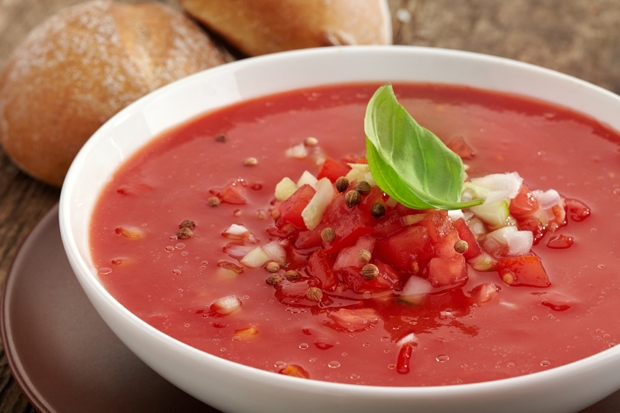We were eating tapas and talking about Spain. Leaving caviar on one side, when jamón ibérico is at its best, there is nothing better to eat. In the Hispania restaurant, it is always at its best. Nothing could match it, although Hispania’s cured leg of beef, the anchovies, the black pudding and the blood pudding all gave their uttermost. But there was one marginal disappointment.
Gazpacho is one of the world’s great dishes, and like several others — haggis is the obvious comparison — it began as a food for the poor, only using cheap and readily available ingredients. Early recipes call for only stale bread, water, olive oil — and garlic. Most modern gazpachos would include tomato, peppers and onion, but the garlic is essential. I thought that Hispania’s version did not have quite enough of a garlic punch.
They had an excuse. The restaurant is round the corner from the Bank of England and most of its customers are drawn from the respectable classes. Especially at lunchtime, such persons might be reluctant to consume a dish that would leave them with garlic breath strong enough to fell an ox.
Equally, I am not sure that I have ever had a gazpacho which lived up to the platonic ideal. There are a couple of other dishes, pork pie and dark chocolate mousse, which also fall short. I imagine a pie with a succulent crust, a topping of jelly and an efflorescence of pig. I have yet to find it. As for the mousse, that should be subtitled the heart of darkness, with an intense blackness which is also somehow sweet. Perhaps that is an impossible combination.
But in its implacability, garlicky gazpacho is expressive of one aspect of the Spanish character. A couple of years ago, I was in Toledo one July day. It was hot, nearer 50 degrees than 40: a dry heat, admittedly, but at Inquisition temperature. I was walking up towards the Alcázar, scene of that magnificent heroic resistance during the Spanish Civil War. To avoid being scorched, it was necessary to cherish every square inch of shade, to move at a funeral-march pace — and never to pass a bar. Rehydration was crucial, and like most European nations except the UK, the Spanish make excellent lager.
Afterwards, a simple meal but as good a gazpacho as I remember. Admittedly, this was the ideal climate for that soup to strut its stuff, but I can still taste its intense refreshment. Even more than the beer, it is an essential antidote to the Spanish high summer.
It would be pleasant to think that gazpacho fuelled the armies of the Reconquista and that after the capture of Ronda, it was used to succour the freed Christian captives who had been enslaved in the quarries, and whose chains now hang in Toledo cathedral. Not so, alas: the earliest references to gazpacho date from the 17th century. But it appears to have originated in Andalucia, so it would have been used to refresh and Godspeed Franco’s crusaders as they advanced northwards.
With the banquet of tapas, we drank some serious sherries, to which I shall return. We moved on to an Albarino, a wine that I have praised in the past. This one, a Filluboa Montealto 2010, was most impressive. Admittedly, my tastebuds were hardly at their freshest, but any white wine that could stand up to the sherries and the tapas has to be exceptional. For reds, we began with a Pago de Carraovejas ’12, from Ribera del Duero. It was only ranked as a Crianza: I do not recall ever drinking a better wine of that grade. Before moving back to sherry, we took care of a Prado Enca, a Rioja Alta from ’06, which more than stood its ground. But that jamón: Jamie Sext is said to have knighted a loin of beef. The jamón deserves a higher accolade: San Jamón.






Comments